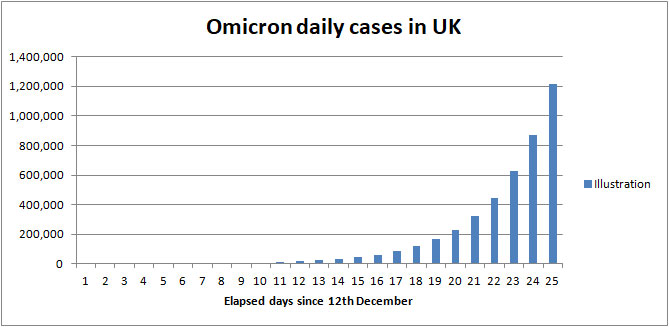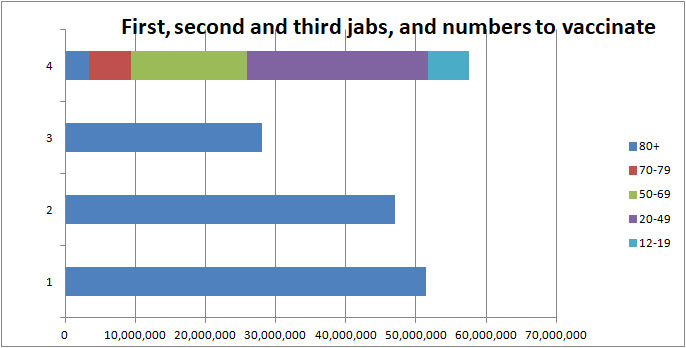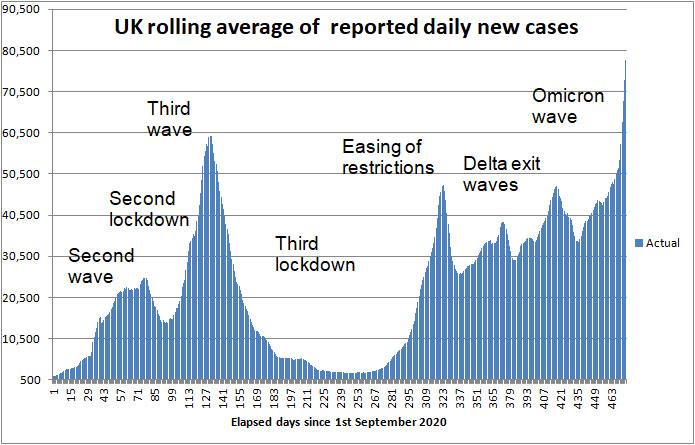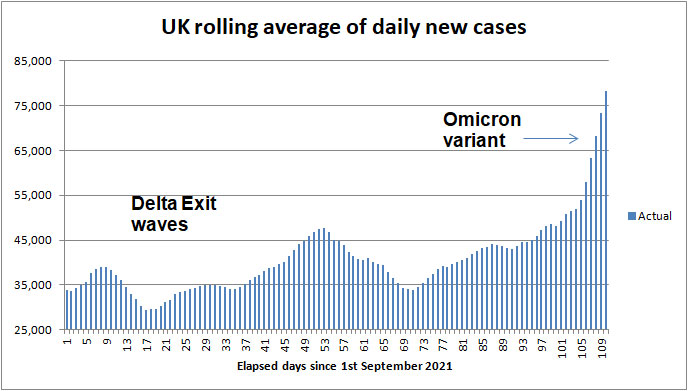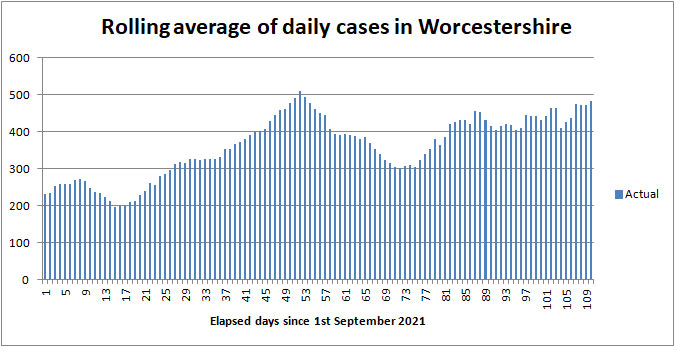
Angus and Rosemary's Miscellany
of Malvern - Other Resources
|
Coronavirus (COVID-19) epidemic weekly update for Malvern Seniors19th December 2021 PM DECLARES OMICRON EMERGENCY COVID Alert Level raised from 3 to 4 Zoe says don't give Omicron for Christmas PreambleWe keep an eye on the published government figures and monitor the media to asses the level of risk for Seniors in the Malvern Hills district. We also provide links to where further information can be found. This page is normally updated every Sunday between 1800 and 2400 hours GMT. Information about Coronavirus can be found on the NHS website: https://www.nhs.uk/coronavirus ContentsFurther information: About the Zoe COVID symptom study About the NHS contact tracing app SummaryBecause the Omicron variant of COVID-19 is extremely infectious scientists expect a very sharp rise in daily cases and hospital admissions leading to the demand for NHS beds possibly outstripping supply in the first half of January. Possibly 25% of Seniors will catch the Omicron variant of COVID-19, but the hope is vaccines and booster jabs will protect most from severe illness and death. However, until as many as 250 patients are hospitalised and some die, epidemiologists won't be able to forecast with confidence the likely course of the Omicron epidemic in the UK and its burden on the NHS. The public can slightly dampen the peak by reducing contacts, for example by working from home and avoiding large gatherings, taking Lateral Flow tests, and wearing better masks. Sadly it is now too late for the vaccine-hesitant to be fully vaccinated before the tidal-wave of Omicron arrives, but that should not put people off getting a first or second dose. Lateral Flow Device kits which only require a nose swab can be used to test for COVID at home, for example before either going to an event or visiting friends and family at Christmas. Seniors should make sure to get their booster jab before Christmas. Don't forget your flu jab as it is expected there could be a greater chance of dying were an unfortunate individual to catch flu and COVID at the same time. A local summary of COVID cases can be found on the Worcestershire Coronavirus Dashboard. Note: use the arrow <> buttons at the bottom of the Dashboard screen to move between pages. Click for Worcestershire County Council COVID-19 news Click for Simple Summary of Malvern numbers on the Coronavirus dashboard Click for the latest UK Government Coronavirus advice Omicron variantUKHSA reports the Omicron variant of concern first found in South Africa is spreading exponentially in the UK and now makes up the majority of cases in London. Scientists will not know the infection/fatality ratio of the Omicron variant in the UK before New Year, but experts appear hopeful booster vaccinations will offer protection from serious illness and death in most cases. The biggest concern is that because Omicron is so transmissible a tidal-wave of COVID hospital admissions could put pressure on NHS beds during the first quarter of 2022. The chart below illustrates how Omicron daily cases might rise in the UK if cases were to grow exponentially with a period of 3 days.
Illustration of rise in daily new cases of Omicron The government has begun publishing information about new cases of Omicron. Click for UK government COVID-19: Omicron daily overview Omicron is already making a difference to daily figures in London, and will probably push up the numbers in Worcestershire after Christmas. Thereafter cases could rise steeply; possibly so steeply that the UKHSA capability to record the figures is overwhelmed. If the government decides not to impose further restrictions after Christmas, some of those with 'severe illness' might have to self-medicate at home for example taking anti-viral medicines, with only the very sickest patients being admitted to hospital. Currently, the government is accelerating the vaccination programme as its main line of defence and the NHS has declared a Level 4 National Incident and is developing contingency plans to cancel elective operations and reallocate wards to COVID patients, should that prove necessary. See also the SAGE minutes of 16th December for situation update: SAGE 99 minutes: Coronavirus (COVID-19) response, 16 December 2021 Eventually according to the SIR model the number of daily cases should reduce as the number of susceptible individuals (not yet infected) in the population shrinks. The peak of the wave and its duration will depend on both the effectiveness of the vaccines and the measures adopted by the public to protect against infection. Ideally in our opinion the government should be:
How to get vaccinatedThe effectiveness of the vaccines falls slightly over time so the most important thing everyone can do now is get a booster jab. All those aged 70+ years should have received either an email, letter or text message from their GP surgery, or a letter from the NHS inviting them to book an appointment for their booster. Under the government's plan to deal with the Omicron Emergency, all those aged 18+ years are now eligible to book a booster 3 months after their second dose. See the NHS website for walk-in opening times and vaccine availability: Alternatively click this link for more information and to book a vaccination on-line: Book a Coronavirus vaccination - NHS (www.nhs.uk) Note: the immuno-compromised may be offered a third jab as part of their primary course, followed by a booster 3 months later. More about vaccinationsPlanOn the 19th November 2021 the JCVI issued new recommendations accepted in Parliament by Sajid Javid. The plan is to vaccinate fully as many people as possible before the Omicron variant becomes dominant in the UK.
There appear no plans at present to vaccinate those aged 5 - 11 years. If you are worried and feel you have been missed out you should contact your GP. On 12th December the PM announced a further target to offer all those aged 18+ years the chance to book an appointment by the end of December. VaccinometerSo that you can see the overall progress of the vaccination programme in the UK, our bar chart below shows the total number of:
Vaccinometer as of 19th December 2021 The population of the UK aged 12+ is about 58M, so were everyone in that age group to be vaccinated under the new plan the lower two blue lines showing 1st and 2nd doses should ideally reach 58M. Currently there are about 6M in this age group who are unvaccinated, which is a lot, and 4M still to get their 2nd dose. In comparison, if children aged 11 years and under are counted, the total population of the UK is roughly 66M. At the current rate of about 30,000 first doses a day it would take 6 months to give all the vaccine-hesitant a first jab, so only 1M out of 6M will benefit during this tidal wave. Achieving herd immunity is now thought to be impossible as fully vaccinated individuals can still catch COVID-19 and pass it on to others; nevertheless vaccination is most important to protect as many individuals as possible of all ages from debilitating long term loss of smell and taste, Long COVID, serious illness, and death. Click for NHS video warning young people of the dangers of the virus for the unvaccinated. Vaccination statistics can be found on the Vaccination tab of the Coronavirus Dashboard. Click for BBC report - Covid vaccine: How many people are vaccinated in the UK Booster jabsThe number of booster jabs given in England can be found in a spreadsheet on the NHS England website. Look in the data section for the COVID-19 daily announced vaccinations Excel file which gives a breakdown of jabs by region and age. Click for NHS COVID-19 vaccinations To date about 47M have had two doses, and 28M booster doses have been administered, suggesting up to 19M to boost in the UK. The vaccination rate has increased from 200,000 to approaching 1M boosters per day which is amazing.
Vaccinations Worldwide (last updated 12th December)A chart of the worldwide vaccination situation can be found on the Our World in Data website. Click for worldwide statistics Note: click the country list on the left hand side of the screen to add or remove countries from the chart. The UK did well to start with but has fallen a little behind some other countries. For example Portugal has double vaccinated 88.8% of its population, Singapore 87.0% and Malaysia 77.6%, compared to 68.5% in the UK. Australia has overtaken the UK with 74.7% fully vaccinated and could soon open its borders to the fully jabbed. Israel has already boosted its population. In Singapore all age groups are now eligible for a booster 5 months after their second dose. We imagine the UK is well ahead of the EU booster programme.
|
| Districts of Worcs | Cases | Weekly increase | Population |
| Bromsgrove | 17,686 | +652 | 98,529 |
| Malvern Hills | 8,720 | +353 | 77,545 |
| Redditch | 15,399 | +416 | 85,317 |
| Worcester | 16,292 | +703 | 103,542 |
| Wychavon | 18,007 | +696 | 126,240 |
| Wyre Forest | 15,428 | +560 | 100,957 |
| TOTAL | 91,532 | +3,380 | 592,130 |
| COMPARE WITH | |||
| County of Hereford | 24,214 | +792 | 195,000 |
| Leicester (city of) | 71,394 | +2,114 | 400,000 |
Cumulative cases reported by PHE in Worcestershire to 19th December 2021
Note: the weekly increase is indicative; the seven day average by area, which varies day to day, is an alternative metric that can be found on the Coronavirus dashboard.
Cases in Worcestershire are mostly up a little on last week. Redditch is down, and Herefordshire is level; the daily case rate in Leicester has begun rising suggesting Omicron could push numbers higher next week.
Cases in Malvern Hills by age group
On the cases tab of the Coronavirus dashboard you can either select the county of Worcestershire or a local authority such as the Malvern Hills, and there you can find a heat map showing cases by age group over time and a chart comparing the number of cases under 60 years with those aged 60+.
The latest figures show the infection rate in those aged 60+ years is fairly level and 6 times lower than in those aged under 60, while the heat map shows since the autumn the infection rate has been highest in those of school age.
Click for cases by specimen date age demographics in the Malvern Hills
Interactive maps
At the bottom of the Coronavirus Dashboard (daily update) page there is an Interactive Map which is coloured to show infection rates across the country.
Cases across much of England and Wales remain high.
Click for Interactive Map of COVID cases
Note: the Interactive Map works on desktop PCs but it's possible you may encounter difficulties using a tablet or smartphone.
Recent weekly cases to 13th December are: North Malvern 26; Malvern Link 7; Pickersleigh 23; Barnards Green 18; Malvern Wells and Priory 21; Callow End and Hanley 18; Upton and Welland 10.
Cases have gone down a little.
Another map can be found on the Zoe COVID Study website indicating extrapolated cases based on reports from those using the Zoe app.
Click for People with COVID (estimated from the Zoe app)
Number of deaths
Statistics on COVID deaths are published by Public Health England, The Office of National Statistics, and NHS England.
PHE figures
Public Health England reports that the cumulative total of COVID (28) deaths in UK hospitals and care homes rose by 779 in the last week to 147,218 while the daily average fell to 111 deaths per day despite cases increasing.
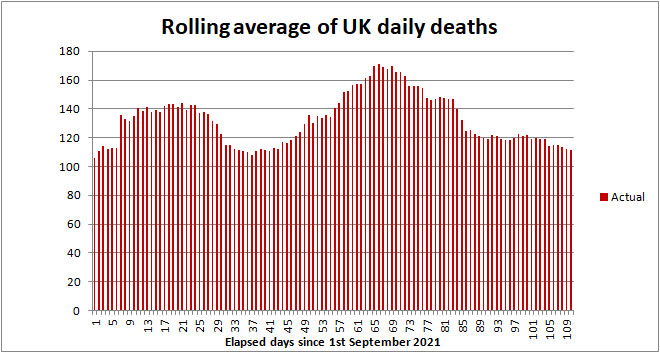
COVID-19 death rate 1st September 2021 to 19th December
Click to view the UK government Coronavirus Dashboard
Since England emerged from lockdown on 19th July almost 19,000 people have died of COVID-19; mostly the elderly.
In comparison averaged over recent years 1,700 people die daily from all causes, so COVID deaths now account for about 7%.
ONS figures
The Office of National Statistics (ONS) separately reports registered deaths in England and Wales where COVID-19 is mentioned on the death certificate. The ONS figures lag the PHE figures by 10 - 14 days and do not include Northern Ireland and Scotland.
Click for national ONS data on deaths (Excel spreadsheet)
The ONS figures are broken down by District providing a glimpse of where deaths are occurring. The provisional cumulative total of COVID related deaths in Worcestershire reported by the ONS up to 3rd December 2021 (week 48 of 2021) is shown below.
Note: the numbers are from the ONS Death Registrations-Pivot table
| Districts of Worcs | Deaths 2020 |
Deaths 2021 |
Week 48 | Population |
| Bromsgrove | 164 | 135 | 3 | 98,529 |
| Malvern Hills | 61 | 97 | 1 | 77,545 |
| Redditch | 108 | 101 | 2 | 85,317 |
| Worcester | 87 | 129 | 1 | 103,542 |
| Wychavon | 157 | 150 | 2 | 126,240 |
| Wyre Forest | 171 | 130 | 1 | 100,957 |
| TOTAL | 748 | 742 | 10 | 592,130 |
Provisional cumulative COVID-19 deaths registered by ONS to 3rd December 2021
In week 48 there was 1 death at home, and 1 in hospital in Bromsgrove; 1 death in hospital in Malvern; 2 deaths in hospital in Redditch; 1 death in hospital in Worcester; 2 deaths in hospital in Wychavon; and 1 death at home in Wyre Forest.
In England and Wales 790 COVID-19 related deaths were reported in the week to 3rd December, 25 less than the week before. Of these 53 were in a care home, 68 at home, 11 in a hospice, 655 in hospital and 3 elsewhere.
Note: summation of rows 9 to 339 of the ONS deaths Registrations-Pivot table.
The provisional UK COVID-19 death toll (as reported by PHE and ONS) for all weeks of the epidemic can be found on the Deaths tab of the Coronavirus Dashboard.
NHS England figures for Worcestershire
The table below shows latest COVID deaths in Worcestershire hospitals reported by NHS England on 17th December 2021.
| Worcestershire | Cumulative deaths | Past week |
| Acute hospitals | 902 | 5 |
| Care hospitals | 64 | 0 |
| TOTAL | 966 | 5 |
Click for NHS COVID-19 total announced deaths
Click for Summary of Malvern numbers on the Coronavirus dashboard
Risk of COVID-19 death by age band (Delta)
NHS England provides an analysis of COVID-19 deaths in hospital in England and Wales by age band. Shown below is a breakdown of deaths for the period 1st August 2021 to 25th November 2021 when the daily death rate fell to 125.
| Age band | Number of deaths | % of deaths |
| 0 - 19 | 29 | 0.3 |
| 20 - 39 | 157 | 2 |
| 40 - 59 | 1,058 | 11 |
| 60 - 79 | 4,062 | 43 |
| 80+ | 4,134 | 44 |
Relative risk of COVID-19 death by age band for Delta variant
Those aged 60+ years account for 87% of deaths compared to 92% last year, but remember that due to vaccination the death rate as a proportion of new cases is five to ten times lower than in 2020.
The majority of these deaths are likely to be of the vaccine-hesitant, those with underlying conditions such as Diabetes, the frail, and those that are immuno-compromised. Pregnant mothers, the overweight and deprived individuals with a poor diet are also said to be at increased risk.
An NHS leaflet offered to patients being admitted to hospital suggests we are at higher risk of complications from COVID-19 infection if we have one or more of the following conditions:
-
Age over 70 or Male over 50;
-
Lung problems (including asthma, COPD, emphysema, bronchitis, bronchiectasis;
-
Heart disease
-
Diabetes
-
Chronic kidney disease
-
Liver disease (eg hepatitis, cirrhosis)
-
Brain or nerve problems (eg Parkinson's disease, motor neurone disease, multiple sclerosis, cerebral palsy)
-
You have a condition that increases the risk of infection
-
Take medication that affects the immune system, (eg steroids)
-
Very obese (BMI over 40)
-
Pregnancy
Some COVID deaths are of the fully vaccinated elderly, but remember that broadly speaking we are ten times more likely to die of something else; so don't be over-concerned.
This table can be updated once 100 or so Omicron deaths have been recorded.
Healthcare numbers
The UK government Coronavirus Dashboard includes important information about healthcare statistics and NHS bed occupancy.
| Hospital COVID cases (UK) | Number | Change since last week |
| Patients currently in hospital | 7,611 | +198 |
| Patients on ventilation | 875 | -25 |
| Patients admitted daily | 900 | +61 |
Headline summary of patients in hospital reported on 19th December
Hospital admissions have roughly flat-lined in recent weeks. The number of hospital beds occupied by COVID patients is about 18% of the peak last January.
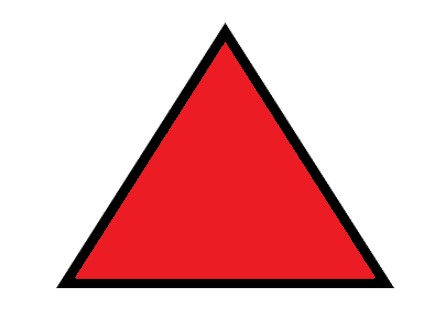 Worcestershire hospital beds
Worcestershire hospital beds
Tabulated figures for bed occupancy in Worcestershire Acute and Care hospitals can be found on the NHS England website.
Click for NHS England COVID-19 Hospital bed Activity
A summary can be found on the UK government Coronavirus Dashboard which reports on 14th December there were 57 COVID-19 patients occupying Worcestershire Acute Hospital beds (up from 55), of which 7 were ventilated beds; roughly 20% of the peak experienced last January.
COVID bed occupancy has roughly flat-lined for many weeks with no sign of a significant upturn so far.
Note: Healthcare statistics can be found on the Healthcare tab of the UK Coronavirus Dashboard. At the top of the page where it says Healthcare in United Kingdom, click the drop down arrow to select Area Type as NHS Trusts, and Area Name as Worcester Acute Hospitals.
Click to view Worcester healthcare figures
Alternatively,
Click for Summary of Malvern numbers on the Coronavirus dashboard
Forecast for the week ahead
Trends suggest that during the next seven days (up to 26th December) the cumulative total of UK COVID-19 cases reported by PHE on the Coronavirus Dashboard could increase by about 800,000 towards 12,161,000 with the 7 day rolling average of daily new cases rising towards 114,000 assuming a mix of Delta and Omicron cases.
In Worcestershire about 3,500 new cases of COVID-19 can be expected, and 350 in the Malvern Hills district, assuming cases of Delta only.
We expect the number of UK COVID (28) deaths to increase by about 770 towards 148,000 during the 7 days ending 26th December 2021, with the average daily death rate flat-lining at 110 deaths per day. These are 'baked in' deaths of those already infected which cannot be avoided.
In the county of Worcestershire, assuming a 0.2% death rate, the 3,380 new cases this week may translate to 7 COVID deaths per week by the first week in January.
Daily hospital admissions are becoming more difficult to predict. In recent weeks admissions have roughly flat-lined despite rising cases, most likely due to both the vaccination programme and a significant proportion of cases being schoolchildren.
We anticipate given the gradual acceleration of Omicron cases that UK daily hospital admissions will lie in the range 900 - 1,000 next week. If it's much higher that will be a cause for concern.
Longer term outlook
Professor John Edmunds with others at the London School of Hygiene and Tropical Medicine have made estimates of the likely spread of the Omicron variant for different scenarios; see paper below.
Modelling the potential consequences of the Omicron SARS-CoV-2 variant in England
Daily cases in January/February might peak roughly in the range 600,000 to 800,000; daily hospital admissions 3,000 to 7,000; and deaths 500 to 1,200.
These are 'best guess' projections as data about the virus is limited.
Daily cases
We have made a simple back of the envelope calculation assuming cases follow a simple S-shaped Logistic Curve matched to the rise in cases of Omicron in order to provide an 'order of magnitude' estimate of what might happen.
Note: this illustration is to provide an indication of the likely direction of travel; the absolute figures could be out by a factor of 4.
We assume the whole population has been booster vaccinated and that 75% are protected from symptomatic illness.
The next chart illustrates how daily cases might rise.
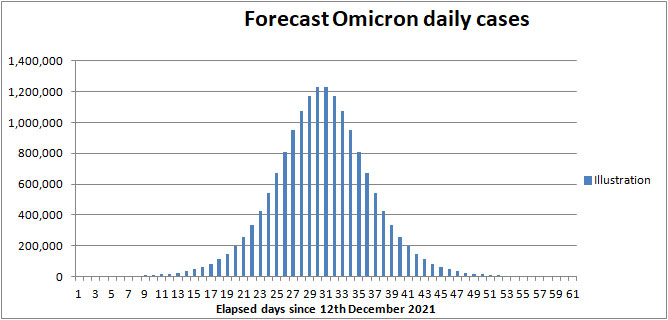
Illustration of possible rise in Omicron daily cases
The illustration suggests COVID cases could rise very rapidly towards one million cases per day peaking about the 11th January 2022.
PCR and Lateral Flow tests probably pick up no more than 50% of cases, so a rise from 50,000 new cases per day to 600,000 might be a fairer comparison with Delta. Roughly a factor of ten.
Daily cases could be more than 50% of the peak between 4th January and 17th January, a period of just two weeks, so that by February, apart from deaths which are delayed, the surge of Omicron could be largely over. However PLAN B and people becoming increasingly cautious, not to mention a Circuit Breaker, could reduce the height of the wave at the expense of extending it.
Daily hospital admissions
Assuming the ratio of daily cases detected by PCR tests to hospital admissions is double that for Delta, the daily demand for hospital admission might head from 800 towards 12,000 by the middle of January.
Looking at it another way, if about 800 COVID patients are admitted to hospital each day and if the peak of Omicron were ten times higher than Delta, that might point to a demand for 8,000 patients to be admitted daily.
In January 2020 the NHS was hard put to cope with 4,000 COVID patients per day, but if we are lucky and Omicron makes people less sick, as Dr John Campbell hopes, then stays in hospital could be shorter, and if more patients were treated at home using the new anti-viral medicines, and the public becomes increasingly cautious, then it's just possible the NHS might cope without a Circuit Breaker.
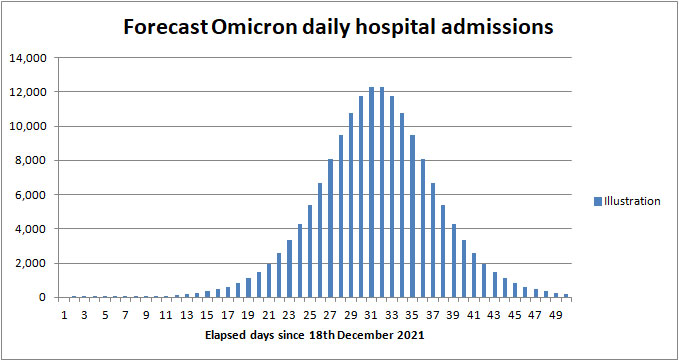
Illustration of possible Omicron daily demand for hospital admission
The ambulance service is already hard pressed, so is a potential bottleneck, and could be overwhelmed by Omicron related 999 calls without military assistance.
A double whammy must be expected as doctors and nurses fall sick coinciding with increasing hospital admissions. Likewise for a few weeks there is likely to be a shortage of all those providing essential services including shop staff, refuse collectors, firemen, police, paramedics, teachers, power industry workers, telecom engineers and delivery drivers.
All branches of society should be making contingency plans to cope with workers off sick next month.
Deaths
Deaths have been occuring on average three weeks or so after testing COVID positive.
Assuming the ratio of daily cases to deaths is double that for Delta then cumulative Omicron deaths between now and the middle of February could be as low as 16,000 with the daily death rate peaking at about 1,200 deaths per day at the end of January before falling towards 50 by the middle of February. Few Omicron deaths can be expected before 5th January and so it is unlikely an accurate estimate of the death toll can be made before the New Year.
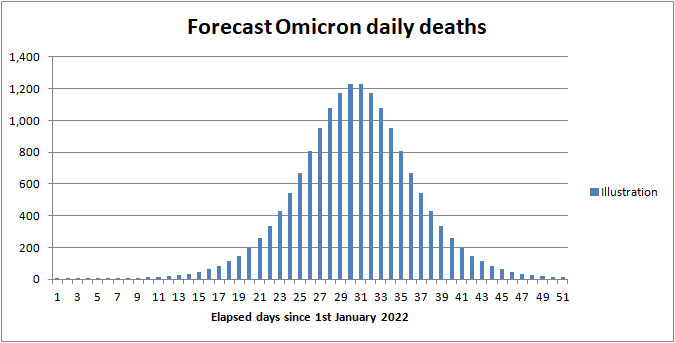
Illustration of possible Omicron daily deaths in UK
Looking at the figures another way, if daily cases of Omicron rise to ten times that of Delta, the death rate might rise from 120 to 1,200 deaths per day, or less if Omicron causes fewer deaths than the Delta variant.
A Circuit Breaker would not significantly reduce the death toll but would simply spread out deaths over a longer period of time.
Ratios
For a fixed level of vaccination, daily cases have been a signpost to whether daily hospital admissions and deaths are going to go up or down. Based on our heuristic 'rules of thumb' hospital admissions and deaths for Delta during December were expected to follow daily cases very roughly in the ratio:
-
Hospital admissions 1:50 of daily cases reported by PHE, lagging by 8 days.
-
Deaths 1:300 of daily cases reported by PHE, lagging by about 20 days.
-
UK Hospital bed occupancy - one fifth of daily cases, lagging by up to a month.
The situation may change, for better or worse, as the Omicron variant replaces Delta but we'll have to wait until January to find out.
Advice for Seniors
 Recently
there have been no more than 10 COVID related deaths per week in Worcestershire
which has a population of 600,000 so we judge the
risk of death for fully vaccinated
Seniors to be
fairly
LOW while the risk of Long COVID might be MODERATE;
see our annex and riskometer opposite.
Recently
there have been no more than 10 COVID related deaths per week in Worcestershire
which has a population of 600,000 so we judge the
risk of death for fully vaccinated
Seniors to be
fairly
LOW while the risk of Long COVID might be MODERATE;
see our annex and riskometer opposite.
6M people remain unvaccinated in the UK and you tell us of obstinate people in Malvern who refuse to get vaccinated. Remember, if you are elderly, have not been vaccinated, and were to catch COVID there is a significant chance that you will either die or your long term health may be seriously damaged, so if you are able get both doses of your vaccine and your booster and continue to take care of yourself and those you love. Also encourage others to be vaccinated.
Click for our risk of death table (for those who have not been vaccinated)
Like Health Minister Sajid Javid and Sir Kier Starmer, it is quite possible, despite a second jab, for Seniors to become ill with COVID-19; some might have mild symptoms like a common cold or hay fever, while others could feel very poorly, but few except the frail, vulnerable, and unlucky will need to be admitted to hospital.
In these increasingly uncertain times the simple safeguards to remember are to:
-
book your booster dose as soon as you are contacted by either your GP or the NHS; between five days and two weeks after the booster most people should be well protected from severe illness caused by the Delta variant and most probably Omicron.
-
wash your HANDS thoroughly, using soap and hot water, for 20 seconds, including after handling deliveries to your home, to kill virus picked up from contaminated surfaces (see note 1);
-
wear either a well fitting FACE covering, FFP2, or N95 face mask when unavoidably near other people for example when in shops, health-care settings, and when using public transport;
-
SPACE at least 2 metres from people you don't feel safe with (see note 2);
-
preferably socialise with friends and other households outdoors in the FRESH AIR else, if you are indoors, either ventilate by keeping windows open as far as is practicable or put a HEPA air purifier in the room;
-
avoid crowded indoor settings and minimise TIME near strangers;
-
self-isolate and take a test if you feel unwell with cold or flu like symptoms; according to the Zoe COVID Study the current top five symptoms amongst the double vaccinated and children, in order of prevalence, are said to be runny nose (74%), headache (72%), sneezing (60%), sore throat (48%), and persistent cough (48%), which are often hard to distinguish from a common cold - you might alternatively suffer from fever with a temperature of up to 103 deg F, and a reduction in sense of taste (see note 3);
-
take a Lateral Flow test before visiting others (see notes 4 and 5);
-
respect others and give them space.
Notes:
1) Wash your hands thoroughly before touching your face to avoid transferring virus from contaminated surfaces to your mouth, eyes and nose. If outdoors use an alcohol based hand gel.
2) Two metres is further than you think - roughly an arm and a walking stick away.
3) The COVID Symptom Study people suggest that if you have symptoms of a common cold there is currently a 1 in 3 chance you might have COVID.
4) If you are attending a festive event take a Lateral Flow test before you go to check you are not taking Omicron to the party.
5) If you are organising an event, ask those attending to take a Lateral Flow test.
6) Depending on your circumstances, think twice about attending an indoor carol service or pantomime with lots of children present who could be spreading the virus.
Annex
Commentary
It seems like we have been here before. Roll the clock back almost two years to March 2020. The Wuhan virus was quadrupling every week, people were very worried and the government imposed a lockdown.
Now Wuhan's 'grandchild' Omicron is spreading exponentially at a similar rate, so far mostly in London, the South East, and Scotland. Chinese scientists say it is much more infectious than Delta, but it may also be spreading more rapidly because two doses of the vaccines designed for the Wuhan strain provide little protection against infection by Omicron.
Ideally a new vaccine is needed, but we only have the old one, and scientists seem to think a third shot, the booster, will stimulate the immune system sufficiently to protect most of us from severe illness and death.
At the moment we know Omicron is spreading very rapidly, but as few people have been admitted to hospital little is known about symptoms and deaths.
Unfortunately we will almost certainly be nearing the centre of the epidemic before epidemiologists have the full facts, so if the government decides to act it will have to do so on uncertain information.
The BBC reports SAGE scientists, erring on the side of caution, are advising the government to impose measures now in order to reduce the likelyhood of daily hospital admissions exceeding 3,000; whilst other commentators have been reporting Omicron is not causing serious illness in South Africa where it originated.
Many Conservative MPs oppose restrictions so it is unlikely the PM will call another Lockdown or Circuit Breaker before Christmas; but with the Dutch government, SAGE and the Labour party favouring a lockdown don't be surprised if Boris Johnson bows to pressure and calls one by New Year.
This week
There have been plenty of scary stories in the media this week, but few facts.
On Monday Labour leader Sir Kier Starmer appeared on TV appealing for people to get their booster jab. It was a very polished performance but he was only repeating what the PM said the day before.
Sajid Javid updated Parliament on the Omicron situation.
There were queues at some walk in vaccination centres and the NHS booking system crashed.
On Tuesday African countries were removed from the red list, acknowledging Omicron was already here.
The 15 minute waiting time after having a COVID jab was abolished to speed up the throughput of vaccination centres.
Sajid Javid was quoted as saying there might already be 200,000 new 'infections' per day in the UK. Where he got that number from is not clear, but it's true that by the time people decide to get tested and with processing delays the 'cases' reported by PHE are several days behind real time, during which Omicron might have doubled or quadrupled.
On Wednesday 4,671 new cases of Omicron were confirmed increasing the total to 10,017. In London 50% of cases were now said to Omicron, compared to 20% in the West Midlands, with cases doubling every two days.
The PM held a COVID press conference:
Click for PM opening statement at COVID-19 press conference: 15 December 2021
Professor Chris Whitty advised that over Christmas we should prioritise those social interactions that matter most to us, and de-prioritise others.
On Thursday Prof Chris Whitty answered questions at a special meeting of the House of Commons Health and Social Care Select Committee.
Click to watch Health and Social Care Committee Thursday 16 December 2021
France banned tourists from the UK from Saturday 18th December, which will upset the Christmas plans of many.
On Saturday the Netherlands announced a lockdown starting on 19th December and lasting to at least the 14th January.
The Mayor of London Sadiq Khan declared a Major Incident due to steeply rising cases of Omicron in some boroughs such as Hammersmith and Fulham, where vaccination rates are lower than average, possibly leading to the sickness of NHS and emergency service workers.
The media suggested the UK government is thinking of a Circuit Breaker or Lockdown, as suggested by both SAGE and Independent SAGE.
Click for Independent SAGE emergency statement calling for a Circuit Breaker
UKHSA Twitter says confirmed cases of Omicron have gone up by 10,000 to 24,968.
Click for UK government COVID-19: Omicron daily overview
Euro News had a report about what is happening around Europe.
COVID in Europe: Records broken as UK and Denmark see Omicron surge
The latest SAGE minutes were published which provide a good summary of the current situation:
SAGE 99 minutes: Coronavirus (COVID-19) response, 16 December 2021
On Sunday Sajid Javid appeared on the last edition of the Andrew Marr show, (which can be found on the BBC I-player) and on the Sky News Trevor Philip show. He gave no indication of further measures and said nothing could be ruled out.
What might happen next
Cases of Omicron appear to have overtaken Delta in London, but so far there has been little impact on Worcestershire. UK cases can be expected to rise sharply after Christmas and into the New Year, but how sick the virus makes us has yet to be established and no doubt the government will be watching the graph of hospital admissions very carefully ready to call a lockdown if the upward curve becomes too steep.
All we can do for now is stick with present plans, keep an eye on the figures as Christmas Day approaches, keep taking Lateral Flow tests, and be prepared to modify our behaviour should that become necessary.
COVID video updates
The usual charts can be found in the Zoe COVID Study and Independent SAGE weekly updates. The chief topic is once again the Omicron variant.
Click to watch Tim Spector's Zoe COVID Study 16th December update
Click to watch Independent SAGE 17th December update
Dr John Campbell is another interesting commentator providing commentaries on YouTube.
Click to watch Dr John Campbell's 17th December Omicron predictions
U3A
U3A groups are packing up for Christmas. The Social History group has decided to cancel its party.
Overseas travel
Refer to current government advice, and prepare contingency plans in case circumstances change.
From 18th December 2021 UK tourist are banned from France.
Click for BBC report - France travel ban: UK tourists need essential reason for entry
From 19th December it sounds as though UK tourists will be banned from Germany due to fears about Omicron.
From 10th January 2022, travellers to the EU may have to show evidence of a booster vaccination if 9 months have elapsed since their last jab.
List of vaccines
Here is the updated list of COVID-19 vaccines ordered by the UK. It looks as though for now the government has settled on Pfizer as first choice with Moderna second and Astrazeneca held in reserve.
Valneva has been cancelled, and approval has not yet been sought for using Novavax in the EU and US although approval has been sought for use in third world countries.
For two doses plus boosters, only about 200M doses will be needed in 2021 and Jan/Feb 2022 for the population of the UK. The government has now signed deals to buy 114 million additional doses of the Pfizer (54M) and Moderna (60M) vaccines to use in 2022 and 2023.
The press announcement goes on to say that 60M doses of Novavax vaccine are expected to be delivered in 2022 and 7.5M doses of GSK/Sanofi, so there seems no intention to cancel these late arrivals.
Click for Guardian report - Novavax expected to be become fourth Covid vaccine available in UK
| COVID-19 vaccine | Doses ordered (million) | Status |
| Pfizer BioNTech, two dose, -70 deg C | 40+60+35 | Approved, deliveries continuing, made in Belgium (EU). An additional 60M doses have been ordered for booster shots for the most vulnerable in the autumn. A further 35M doses were ordered in August 2021 for delivery in 2022. |
| Astrazeneca, two dose, fridge | 100 | Approved for those aged 30+ years; deliveries continuing. Batches made in UK, Belgium and India. |
| Moderna, two dose, -20 deg C | 7+10 | Approved. First deliveries to Wales and Scotland 7th April 2021 then England 13th April; mainly for those aged under 50 years awaiting vaccination. |
| Valneva, two dose | 60+40 order cancelled |
A jab from French company Valneva will be made in Livingston, West Lothian, Scotland. Order cancelled September 2021. Delivery had been expected to start in second half of 2021. |
| Janssen, single dose | 20 | Approved, a jab from Belgian firm Janssen, owned by Johnson and Johnson; UK approval 28th May. Order reduced from 30 to 20M. |
| Novavax | 60 | A jab manufactured by US firm Novavax being made in Stockton-on-Tees UK; phase III trials complete, but approval has not yet been sought in EU and US. Glaxo Smith Kline (GSK) contracted to fill and package vials. Delivery expected in 2022. |
| GSK Sanofi | 60 | Some delay due to adjusting the formula to give better protection to the elderly; expected approval and delivery of 7.5M doses in 2022. |
| Curevac | 50 ? | Contract placed with German company Feb 2021. Possible source of new variant vaccine; disappointing trial results have resulted in the company working on a second generation vaccine. Future uncertain. |
Table of vaccines ordered by the UK government
Present rate of new cases and risk
The average rate of infection per 100,000 population per week is shown in the following table.
| Region | Case rate |
| England | 597 |
| Wales | 520 |
| Scotland | 502 |
| Northern Ireland | 636 |
| London (region) | 1,065 |
| Worcestershire | 519 |
| Malvern Hills | 342 |
Seven day Case Rate per 100,000 reported 18th December 2021
London is added to the table this week as it has become an Omicron hotspot.
Excluding London, the case rate is up a little on the previous week; apart from the Malvern Hills, which is down a tad.
As a yardstick we suggest a figure of below 10 can be considered LOW, so there is a long way to go.
Based on back of the envelope sums in earlier blogs, the probability of fully vaccinated Seniors, without underlying conditions, catching and dying from COVID-19 is now possibly somewhere in the range 1 in 1,000 to 1 in 10,000 per year so we judge the risk fairly LOW compared to the risk of dying from other causes. Perhaps as many as 3% to 5% of people who catch COVID suffer from Long COVID so that risk might be assessed MODERATE.
The risk of death from Coronavirus for unvaccinated children and healthy teenagers is said to be small so for them the risk is LOW.
How to request a COVID test
In order to protect others it is important to get a test and self isolate if you feel unwell with either classic COVID symptoms, or cold and flu like symptoms which can be caused by the Delta variant.
There are now two types of test you can get. The more accurate PCR test involving a throat and nose swab which is sent to a laboratory for analysis and the Lateral Flow Device test.
Click for government guidance on types of tests
Getting a PCR test
Click the link below for information on how to get a free NHS PCR test if you think you may have Coronavirus:
https://www.gov.uk/get-coronavirus-test
We feel the website discourages people from seeking a PCR test who don't have all the classic symptoms. If you feel strongly enough, press on answering the questions so as to get your PCR test.
In case of difficulty you can try phoning the Coronavirus contact centre by dialing 119.
Alternatively settle for a 'Nasal swab' Lateral Flow Device test in the comfort of your own home (see below).
According to Google there is a 'drive through' COVID testing station at County Hall near the Countrywide Centre, and a 'walk through' at Pershore.
There is also a COVID testing station at the Worcester Royal Hospital for screening patients before admission.
If you cannot get to these you can order a home PCR test kit.
If you test COVID positive you should self-isolate for 10 days.
Getting a Lateral Flow Device test
Lateral Flow Device tests (LFD) can either be booked at Claremont Pharmacy in Barnards Green, Evans Pharmacy in Malvern Link, or taken at home.
The test is intended to screen those who do not show the classic symptoms of COVID-19 and provides a means to check you are 'virus free' at home - either before visiting an elderly person, going to work, or attending a crowded event. It also provides a means to check whether or not you have Coronavirus if you are feeling poorly with cold and flu like symptoms.
 You
can collect home test kits,
for example packaged as the COVID-19 Self-Test (Rapid Antigen Test) in boxes
of 7 tests, from Malvern library, the Co-op, and most pharmacies such as Boots and Murrays in Church
Street, Claremont House and Lloyds in Barnards Green, Murrays at Prospect
View, Evans and Murrays in Malvern Link, and Boots and Morrisons on the
Enigma Retail Park.
You
can collect home test kits,
for example packaged as the COVID-19 Self-Test (Rapid Antigen Test) in boxes
of 7 tests, from Malvern library, the Co-op, and most pharmacies such as Boots and Murrays in Church
Street, Claremont House and Lloyds in Barnards Green, Murrays at Prospect
View, Evans and Murrays in Malvern Link, and Boots and Morrisons on the
Enigma Retail Park.
If collecting from a pharmacy you now have to go on-line and get a collection code to present to the pharmacy in order to obtain a pack of 7 tests. This involves giving NHS Test and Trace your email and/or mobile phone number and address.
http://www.gov.uk/get-collect-code
The LFD now comes in two versions.
-
The Throat and Nose Swab kit;
-
The Nose Swab only kit (Orient Gene, Acon Flowflex and MP Biomedicals).
(Lateral Flow Device cassette shown on the right).
ACON Flowflex comes in a blue and white pack.
Orient Gene comes in a green and white pack.
MP Biomedicals come in a blue, white and grey pack.
Click for instructions for using the LFD test kits
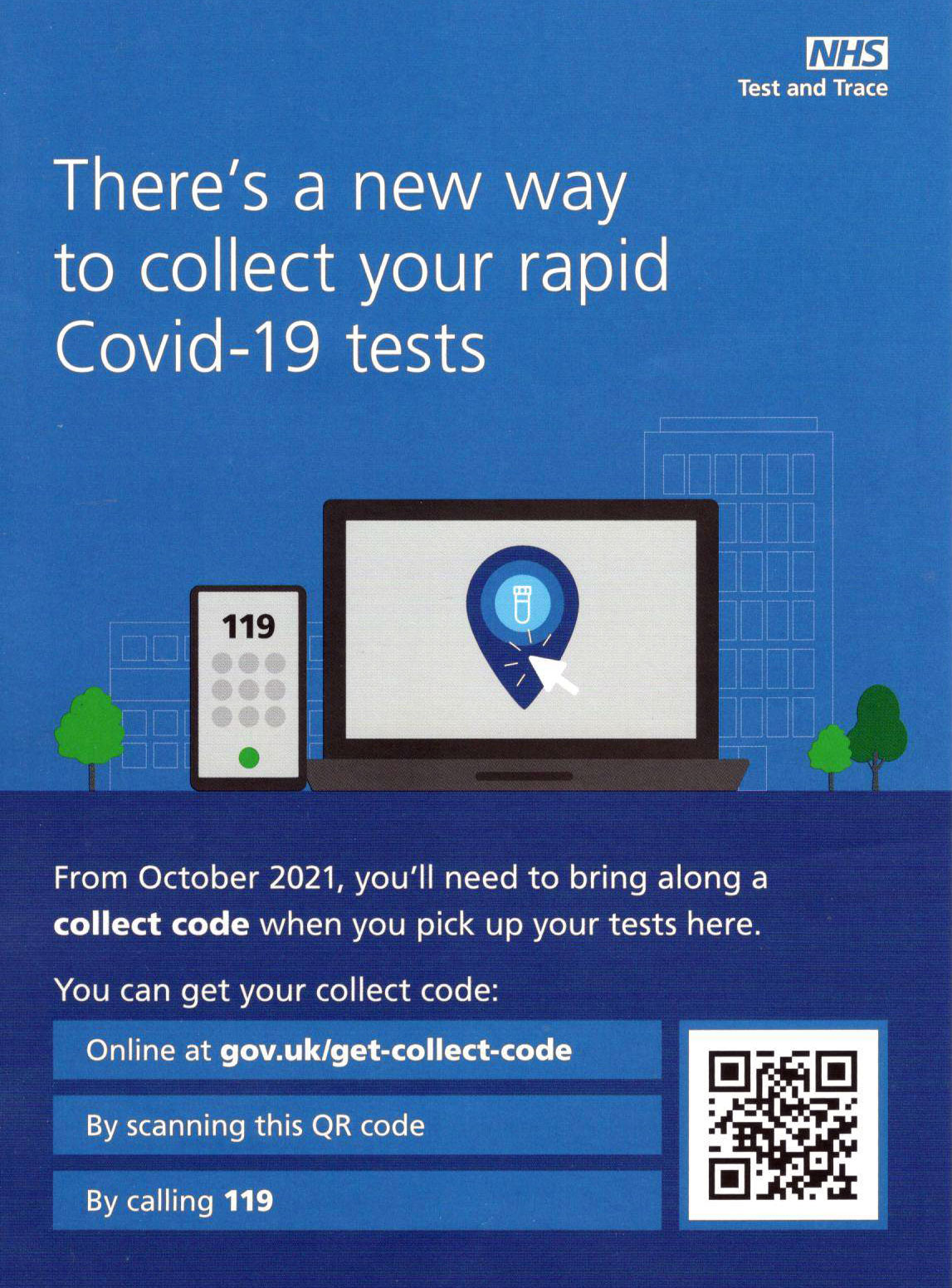
Leaflet at Boots the Chemist
The new Nasal swab test kit which only requires a nose swab is the easiest to use and the best one to get but it is not yet widely available. On 10th November we found Boots in Church Street and Malvern Library were still supplying the old Throat and Nose kit; Murrays in Church Street had the new kits and Malvern library thought the library in St John's Worcester might have the new kits.
Click for NHS information on Rapid Lateral Flow Test sites and collection sites in Malvern
Hint: to see the list, click on 'filter' and then 'pick up sites for test kits' checkbox.
Click for WCC info about Lateral Flow Tests
In our opinion, many Seniors will find the classic Throat and Nose Swab home test kit difficult to use as you need to rub the tonsils or thereabouts with the swab-stick without touching the tongue, teeth, cheeks, gums or any other surface before swabbing the nose. Doing this standing in front of a mirror on your own without gagging while holding a torch in the other hand, won't be easy unless you have a steady hand and good eyesight.
The Nose Swab kit is by far the best one for testing yourself at home.
If you test COVID positive you should isolate and take a more accurate PCR test to confirm the result.
NHS Test and Trace want people to report the result of their home LFD tests within 24 hours at:
www.gov.uk/report-covid19-result
This helps NHS Test and Trace monitor where the issue of the free LFD tests is proving most effective and the spread of the disease.
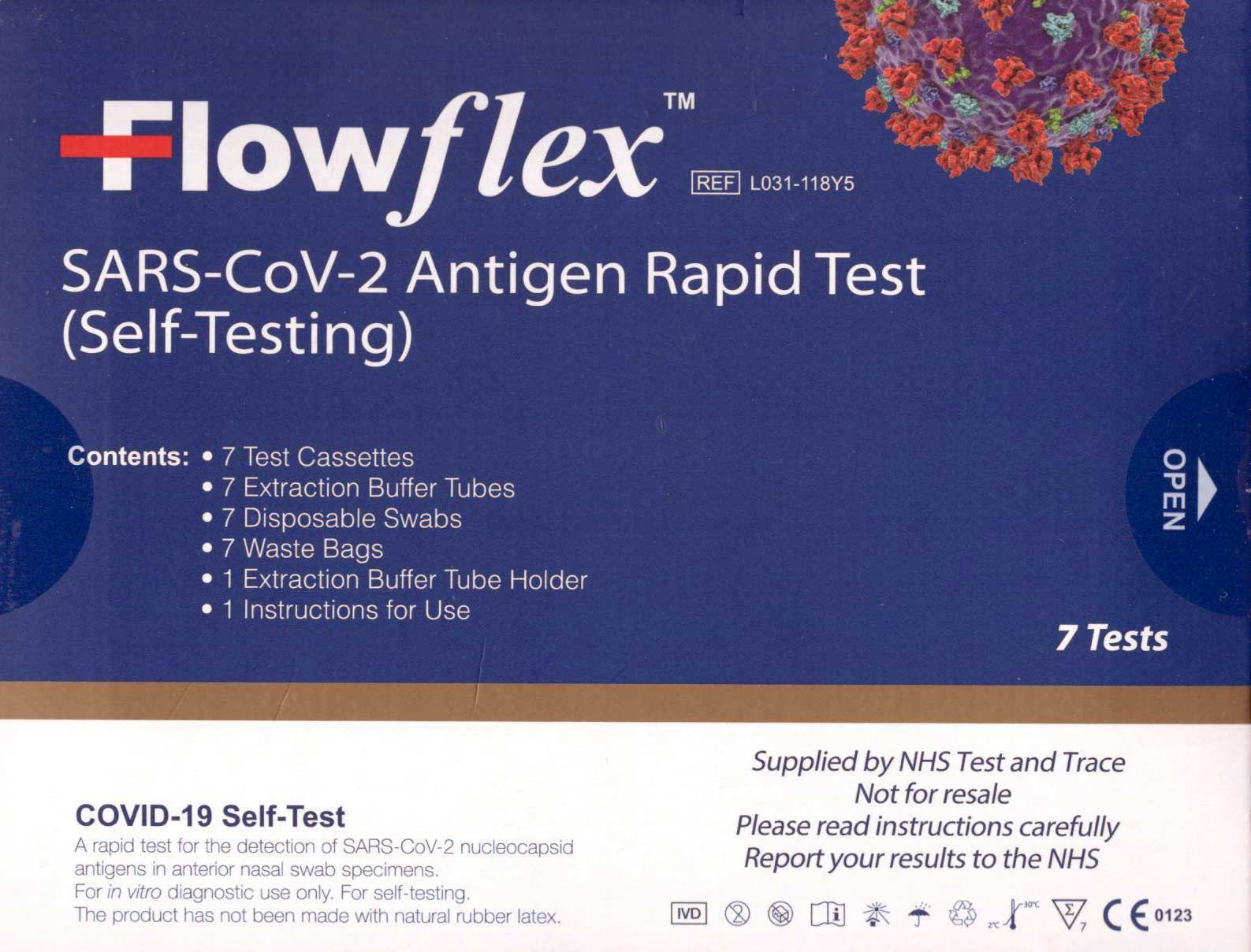
Nose swab home test kit obtained from Murrays
About the COVID Symptom Study app (Zoe)
 You
can help others by downloading the COVID Symptom Study app onto your
smart-phone or Ipad and reporting how you feel either daily, or as you are
able. Note there is no desktop PC version for Windows.
You
can help others by downloading the COVID Symptom Study app onto your
smart-phone or Ipad and reporting how you feel either daily, or as you are
able. Note there is no desktop PC version for Windows.
For further details click this link: https://covid19.joinzoe.com
The Zoe app, which is easy to use, allows you to report whether or not you are feeling well and if you have had a test for COVID. This helps Kings College London monitor the spread and symptoms of the disease and give advice to government. This is an important source of data as we progress through the EXIT wave.
There are questions allowing you to enter your vaccine type and whether any side effects; this now includes boosters and flu jabs.
About the NHS COVID-19 contact tracing app (England)
Release of the NHS COVID-19 contact tracing app for Apple and Android smartphones was announced on 24th September 2020.
Click this link for NHS Coronavirus app information
If you have been close to someone who has tested COVID positive, your smart-phone will be pinged and you may be advised to self-isolate
The rules for contacts self isolating keep changing. The latest is that if you are unvaccinated you must isolate for 10 days.
If you are fully vaccinated you can alternatively take Lateral Flow tests for 7 days. Should you test positive you should isolate and then take a PCR test to confirm.
Bear in mind double vaccinated individuals can still catch the Delta variant of COVID and pass it on to others.
About the NHS app and Covid Pass
An NHS COVID Pass shows your coronavirus (COVID-19) vaccination details and/or test results. This is your COVID-19 status. You may be asked to show your pass to travel abroad, or at events and venues in England asking for proof of your COVID-19 status.
For large UK events you may get in either by the fact:
-
you are fully-vaccinated;
-
you have had COVID as recorded by a positive PCR test;
-
you have taken and reported a recent Lateral Flow test.
You will need the NHS app installed on your smartphone and be registered with the NHS in order to display your vaccination status.
Note: this is not the NHS COVID-19 app
If you don't have a smartphone you should be able to login from a PC to obtain a printed copy.
Click to login from a desktop computer or laptop
You can use your NHS login when signing in to report the result of Lateral Flow Device tests taken at home, which must be done within 24 hours.
Summary of Links
Symptoms
Article about the effects of Coronavirus on the human body
Reporting and how to obtain a test
How to get a test
https://www.nhs.uk/coronavirus
About joining the Zoe COVID Symptom Study:
Guidance
UK government Coronavirus guidance
COVID-19 Response: Autumn and Winter Plan 2021 for England
COVID Alert states
Guidance on UK COVID-19 alert level methodology: an overview
COVID-19 Alert Level lowered to 3 on 10th May 2021
Tiers
Guidance on tiers: what you need to know
Government postcode checker to find tier for other areas
Statistics
UK government COVID-19: Omicron daily overview
UK government Coronavirus Dashboard
Coronavirus Dashboard Interactive Map
ONS data on deaths in England and Wales (Excel spreadsheet)
NHS England COVID-19 Daily Deaths
NHS England COVID-19 Hospital Admissions
NHS England vaccination statistics
Worcestershire Coronavirus Dashboard
Worcestershire COVID-19 Vaccinations Dashboard
HSA COVID-19 vaccine weekly surveillance reports
A glimpse of the worldwide vaccination situation can be found on the Our World in Data website.
Click for chart showing % vaccinated
Modelling
A forecast of the progression of the COVID-19 epidemic can be found on a University College London (UCL) website.
Click for UCL Long-term forecasting of the COVID-19 epidemic
A projection of the future COVID-19 death toll and daily deaths can be found on The Institute for Health Metrics and Evaluation website.
Click for IHME projection of COVID-19 deaths
Reports
ONS Coronavirus (COVID-19) Roundup
The bigger picture
Worldometer summary of coronavirus cases worldwide
European Centre for Disease Prevention and Control info
https://www.ecdc.europa.eu/en/geographical-distribution-2019-ncov-cases
World Health Organisation info
Window on the USA
Centre for Disease Control (CDC)
American Association of Retired People (AARP)
Worcestershire
Help:
http://www.worcestershire.gov.uk/here2help
Worcestershire County Council COVID-19 information:
http://www.worcestershire.gov.uk/coronavirus
Here you will find a useful link,
'Website: Number of new cases by date in Worcestershire'
which displays interesting COVID charts and statistics for Worcestershire
Miscellaneous
Spanish Flu
Dr Jeff Kildea's commentary about the 1919 outbreak of Spanish Flu in Australia
Views of Martin McKee, Professor of European Public Health
Follow Martin McKee on Twitter
SAGE membership
Scientific Advisory Group for Emergencies (SAGE)
Scottish government:
Link to Scottish Government website
Link to Postcode checker for COVID restrictions by protection level in areas of Scotland
Welsh Government:
Guidance on COVID alert levels in Wales

The interpretations and opinions expressed are our own
Last updated 19th December 2021
 Blogs
>
Blogs
>